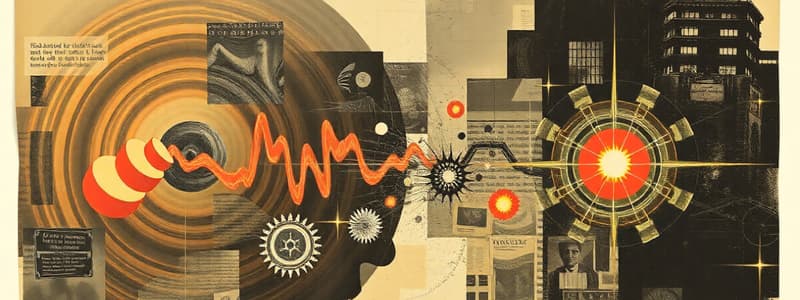Podcast
Questions and Answers
Which of the following is the correct formula for calculating Kinetic Energy (KE)?
Which of the following is the correct formula for calculating Kinetic Energy (KE)?
- KE = 1/2 mv² (correct)
- KE = 1/2 mv
- KE = mv
- KE = mv²
Potential energy is the energy of an object in motion.
Potential energy is the energy of an object in motion.
False (B)
What is the SI unit for both kinetic and potential energy?
What is the SI unit for both kinetic and potential energy?
joules
According to the order of operations, $5 * 2 + 5$ should be calculated with the ______ operation first.
According to the order of operations, $5 * 2 + 5$ should be calculated with the ______ operation first.
What is the main concept behind potential energy?
What is the main concept behind potential energy?
Which of the following best describes mechanical energy?
Which of the following best describes mechanical energy?
Match the energy type with its correct description:
Match the energy type with its correct description:
The acceleration due to gravity is approximately 9.8 m/s².
The acceleration due to gravity is approximately 9.8 m/s².
Radiant energy includes only visible light.
Radiant energy includes only visible light.
What type of energy is often referred to as 'heat energy'?
What type of energy is often referred to as 'heat energy'?
The sun radiates the entire ___________ spectrum.
The sun radiates the entire ___________ spectrum.
Which of these is an example of radiant energy?
Which of these is an example of radiant energy?
Mechanical energy is only possessed by objects that are stationary.
Mechanical energy is only possessed by objects that are stationary.
Match the energy type with its description:
Match the energy type with its description:
What is the connection between a substance's temperature and thermal energy
What is the connection between a substance's temperature and thermal energy
Light bulbs radiate or emit_________.
Light bulbs radiate or emit_________.
What does KE represent in the formula provided?
What does KE represent in the formula provided?
Energy transformations always happen in a single step.
Energy transformations always happen in a single step.
What type of energy is converted into electrical energy in the example given?
What type of energy is converted into electrical energy in the example given?
Energy transformations can happen one after another and are called energy ______.
Energy transformations can happen one after another and are called energy ______.
Match each term with what it represents in the provided content:
Match each term with what it represents in the provided content:
Besides sound and thermal energy, what other form does energy transform into during a pendulum's swing?
Besides sound and thermal energy, what other form does energy transform into during a pendulum's swing?
At the top of a pendulum's swing, it has maximum kinetic energy.
At the top of a pendulum's swing, it has maximum kinetic energy.
What force causes a pendulum to gain speed as it falls?
What force causes a pendulum to gain speed as it falls?
When a pendulum slows down and gains height, its kinetic energy is transformed back into ______ energy.
When a pendulum slows down and gains height, its kinetic energy is transformed back into ______ energy.
Match the following items with the type of energy transformation that primarily occurs:
Match the following items with the type of energy transformation that primarily occurs:
What is the first step when solving problems related to the law of conservation of energy?
What is the first step when solving problems related to the law of conservation of energy?
The total mechanical energy of a pendulum remains constant if we ignore air friction.
The total mechanical energy of a pendulum remains constant if we ignore air friction.
What two forms of energy are mentioned in the context of the pendulum's transformation process?
What two forms of energy are mentioned in the context of the pendulum's transformation process?
Energy is transformed to sound and ______ energy.
Energy is transformed to sound and ______ energy.
What should be the next step after identifying the energy types involved in a conservation of energy problem?
What should be the next step after identifying the energy types involved in a conservation of energy problem?
Flashcards
What is kinetic energy?
What is kinetic energy?
Kinetic energy is the energy an object possesses due to its motion.
What is potential energy?
What is potential energy?
Potential energy is stored energy that an object has due to its position, charge, or stresses.
How is kinetic energy transferred?
How is kinetic energy transferred?
Kinetic energy can be transferred between objects when they collide, or it can transform into other types of energy.
What is the SI unit for energy?
What is the SI unit for energy?
Signup and view all the flashcards
How do you calculate kinetic energy?
How do you calculate kinetic energy?
Signup and view all the flashcards
What is acceleration due to gravity?
What is acceleration due to gravity?
Signup and view all the flashcards
How is potential energy useful?
How is potential energy useful?
Signup and view all the flashcards
Mechanical Energy
Mechanical Energy
Signup and view all the flashcards
Radiant Energy
Radiant Energy
Signup and view all the flashcards
Visible Light
Visible Light
Signup and view all the flashcards
Infrared Radiation
Infrared Radiation
Signup and view all the flashcards
Electromagnetic Spectrum
Electromagnetic Spectrum
Signup and view all the flashcards
Heat Energy
Heat Energy
Signup and view all the flashcards
Temperature
Temperature
Signup and view all the flashcards
Radiation
Radiation
Signup and view all the flashcards
Conduction
Conduction
Signup and view all the flashcards
Law of Conservation of Energy
Law of Conservation of Energy
Signup and view all the flashcards
Energy Transfer
Energy Transfer
Signup and view all the flashcards
Energy Transformation
Energy Transformation
Signup and view all the flashcards
Total Energy Remains Constant
Total Energy Remains Constant
Signup and view all the flashcards
Energy Before
Energy Before
Signup and view all the flashcards
Energy After
Energy After
Signup and view all the flashcards
Energy In
Energy In
Signup and view all the flashcards
Energy Out
Energy Out
Signup and view all the flashcards
Kinetic Energy
Kinetic Energy
Signup and view all the flashcards
Potential Energy
Potential Energy
Signup and view all the flashcards
What is the energy conservation formula?
What is the energy conservation formula?
Signup and view all the flashcards
What is an energy chain?
What is an energy chain?
Signup and view all the flashcards
What does the energy conservation formula imply?
What does the energy conservation formula imply?
Signup and view all the flashcards
What is the relationship between potential energy and work?
What is the relationship between potential energy and work?
Signup and view all the flashcards
What is the law of conservation of energy?
What is the law of conservation of energy?
Signup and view all the flashcards
What is a pendulum?
What is a pendulum?
Signup and view all the flashcards
What is potential energy in a pendulum?
What is potential energy in a pendulum?
Signup and view all the flashcards
What is kinetic energy in a pendulum?
What is kinetic energy in a pendulum?
Signup and view all the flashcards
How does energy transform in a pendulum?
How does energy transform in a pendulum?
Signup and view all the flashcards
How to solve energy problems?
How to solve energy problems?
Signup and view all the flashcards
Energy Interaction
Energy Interaction
Signup and view all the flashcards
Solving Energy Problems
Solving Energy Problems
Signup and view all the flashcards
Study Notes
Introduction to Energy and Kinetic Energy
- Work is done when a force causes a change in an object's motion. Force can be a push or a pull.
- Energy is the ability to do work, enabling changes in motion.
- Energy has no mass or volume, unlike matter.
- Energy is transferred when work is done.
- Different types of energy exist, including mechanical, chemical, electrical, light, and thermal energy.
- Energy can be transformed from one form to another.
Types of Energy
- Kinetic energy (KE) is the energy of motion. The SI unit for kinetic energy is the joule (J).
- Potential energy (PE) is stored energy due to position, stress, or charge. The SI unit for potential energy is the joule (J).
- The formula for calculating kinetic energy is KE = ½ * m * v², where:
- m = mass of the object (in kilograms)
- v = velocity or speed of the object (in meters per second)
- The formula for calculating potential energy is PE = m * g * h, where:
- m = mass of the object (in kilograms)
- g = acceleration due to gravity (approximately 9.8 m/s² on Earth)
- h = height of the object (in meters)
Calculating Kinetic and Potential Energy
- Calculation of kinetic energy requires knowing the object's mass and velocity.
- Calculation of potential energy requires knowing the object's mass, acceleration due to gravity, and height.
Conversion of Units
- Common conversions are provided, including those for length (meters, centimeters, kilometers) and mass (kilograms, grams, milligrams).
Acceleration Due to Gravity
- All objects with mass accelerate towards Earth at a rate of approximately 9.8 m/s².
- This rate, known as the acceleration due to gravity, is constant for objects near the Earth's surface.
- Height affects potential energy, with higher heights corresponding to more potential energy.
Types of Energy (Continued)
- Several types of energy exist, including mechanical, radiant, thermal, electrical, and sound energy. Examples and definitions are provided.
Law of Conservation of Energy
- Energy cannot be created or destroyed, only transformed from one form to another.
- The total amount of energy in a closed system remains constant.
- Energy transformations can occur in a chain, with one type of energy changing into another.
- Efficiency is a measure of how much useful energy is produced compared to the total energy input to a device.
Energy Transformations
- Different forms of energy can change into other forms of energy and be transferred between objects
- Examples of energy transformations are found in everyday life.
- Some energy in transformations is lost as heat.
Potential and Kinetic Energy (Summary)
- Energy is conserved; it can be transferred or transformed but not created or destroyed.
Studying That Suits You
Use AI to generate personalized quizzes and flashcards to suit your learning preferences.




